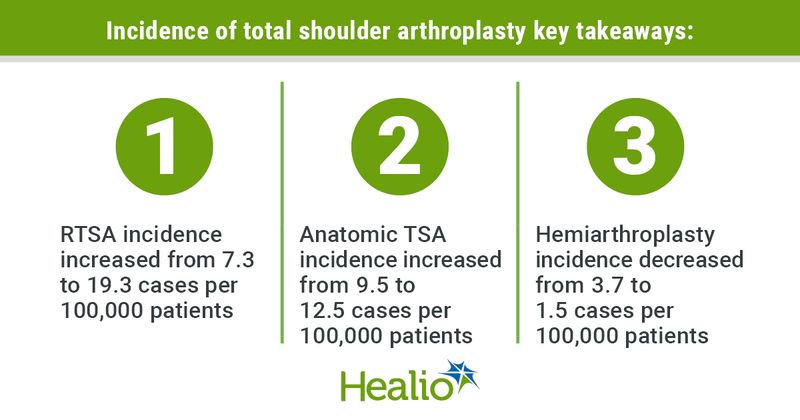Total shoulder arthroplasties ‘increased substantially’ in the US from 2012 to 2017
Click Here to Manage Email Alerts
The incidence of primary reverse and anatomic total shoulder arthroplasty has “increased substantially” in the United States, with the largest increases seen in men and patients aged 50 to 64 years, according to published results.
Researchers from the department of orthopedics at the Johns Hopkins University School of Medicine analyzed incidence rates of total shoulder arthroplasty (TSA) from 2012 to 2017 in their retrospective, epidemiological study. Researchers used U.S. census data along with national hospital data to identify approximately 508,000 cases of reverse total shoulder arthroplasty (RTSA), anatomic TSA and hemiarthroplasty.

Common diagnoses were rotator cuff tear for RTSA, osteoarthritis for anatomic TSA and proximal humerus fracture for hemiarthroplasty.
According to the study, RTSA incidence increased from 7.3 to 19.3 cases per 100,000 patients (22,835 to 62,705 procedures) and anatomic TSA incidence increased from 9.5 to 12.5 cases per 100,000 patients (29,685 to 40,665 procedures), while hemiarthroplasty incidence decreased from 3.7 to 1.5 cases per 100,000 patients (11,695 to 4,930 procedures).
After adjusting data for age and gender, the most dramatic increase was seen in the incidence of men and patients aged 50 to 64 years undergoing RTSA, according to the study.
Researchers hypothesized several explanations for the increased incidence.
“First, the indications for RTSA have expanded since its initial approval by the FDA in 2004 for rotator cuff arthropathy,” the researchers wrote in the study. “While not specifically approved by the FDA, indications have expanded to include proximal humerus fractures, glenohumeral arthritis with glenoid bone loss, inflammatory arthritis, revision surgery and irreparable rotator cuff tears with pseudoparalysis even in the absence of osteoarthritis,” they wrote.
“More orthopedic surgery residents are undergoing specialty fellowship training and the amount of fellowship trained shoulder surgeons is increasing in the U.S.,” the researchers added. “Thus, a greater number of surgeons are being trained with higher volume shoulder arthroplasty exposure, which may also contribute to the higher rates of RTSA and anatomic TSA being performed,” they wrote.
“One important finding of this study is the increase in RTSA seen in patients less than 65
years of age. Historically, the majority of patients undergoing RTSA have been elderly and with a mean age of 73 years,” the researchers concluded. “A continued increase in utilization of RTSA is expected as the indications for this surgery expand, the surgical expertise increases and the technology improves.”

